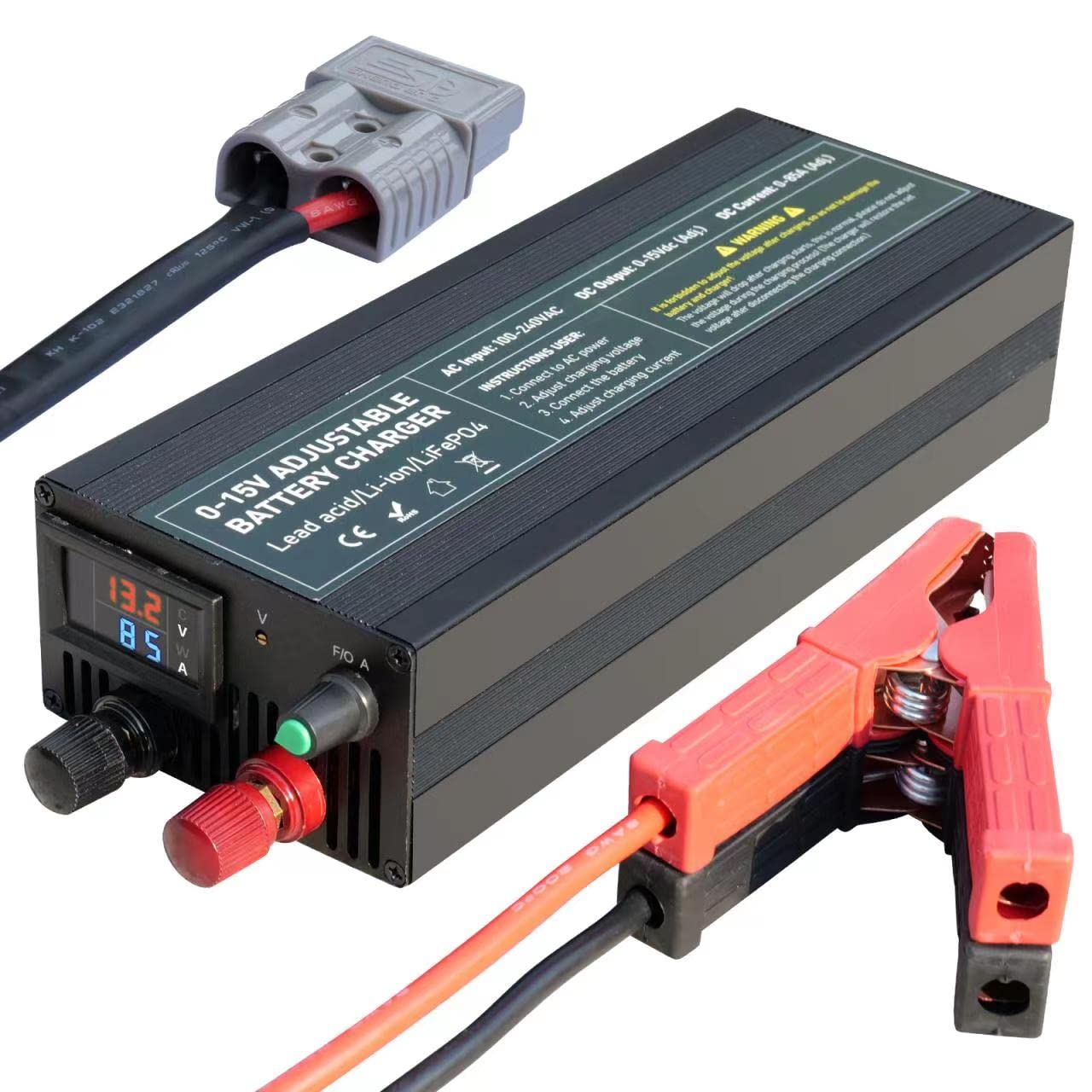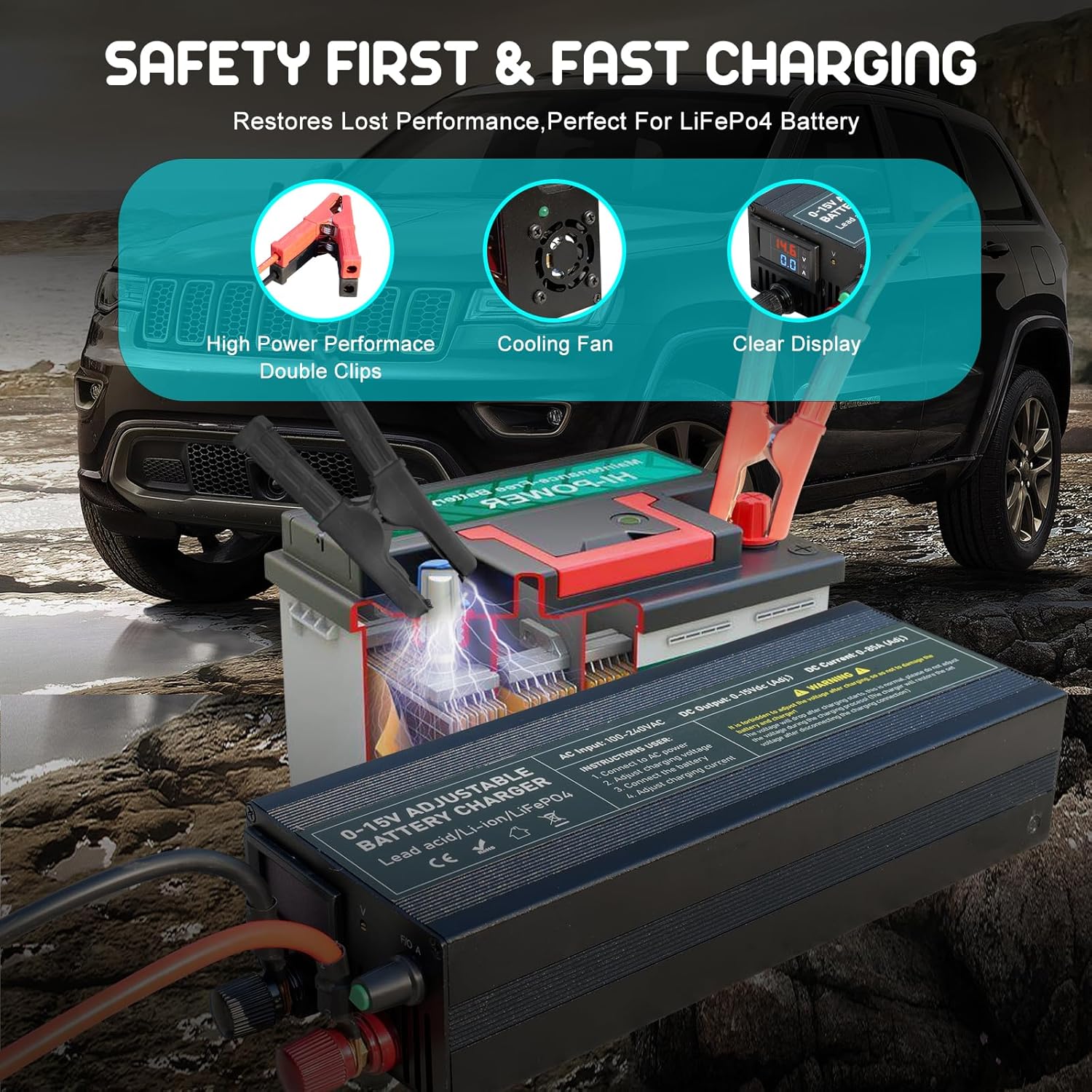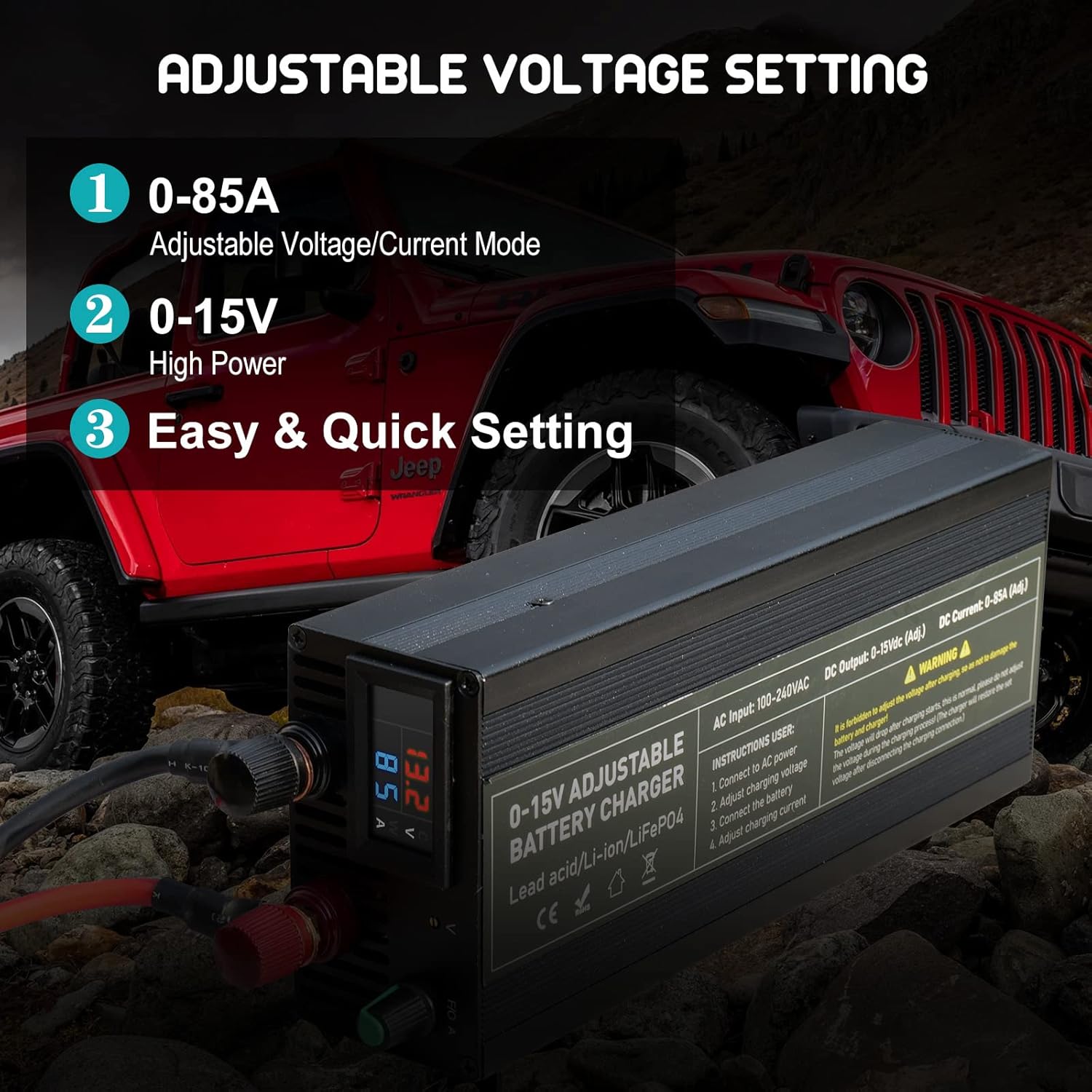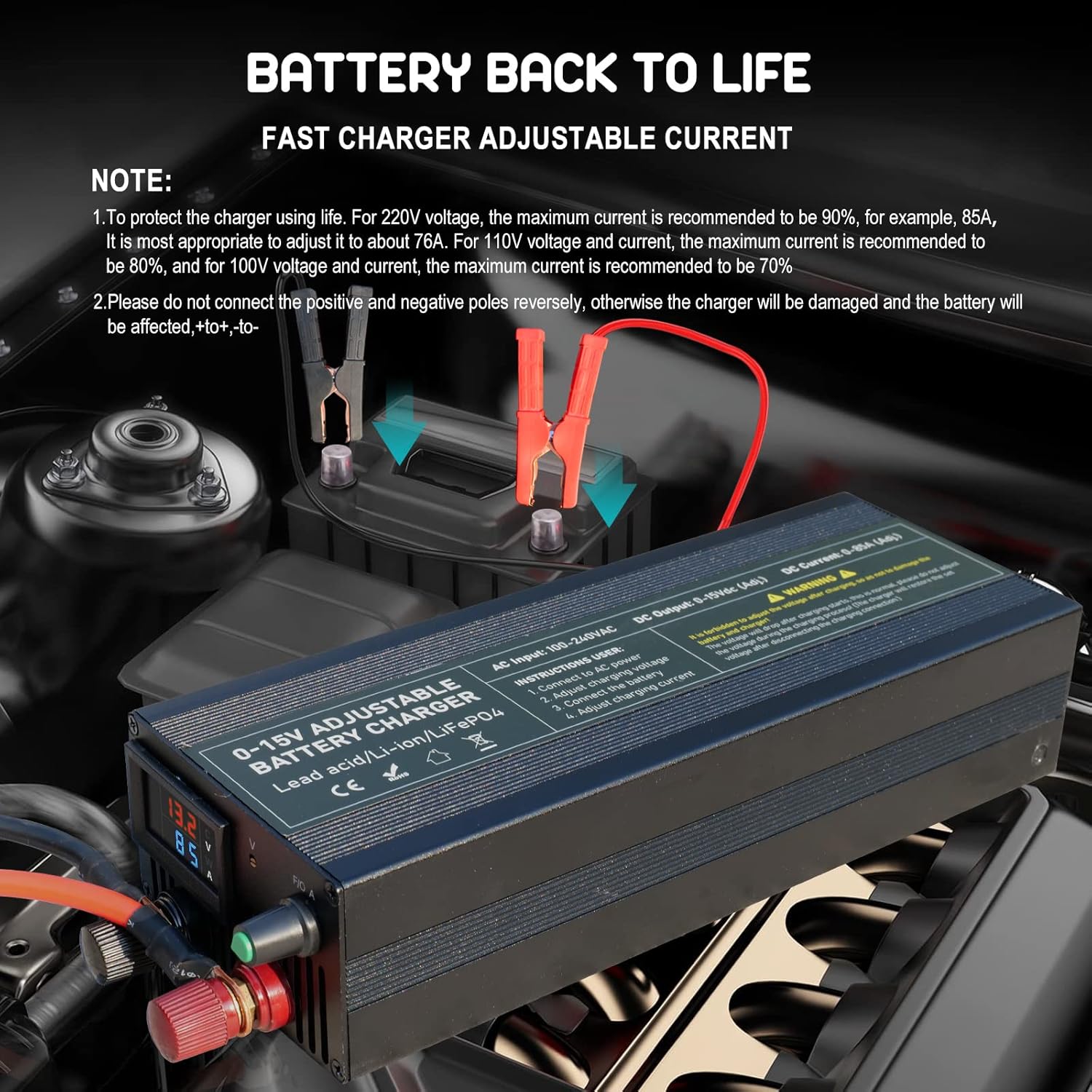Descrição do Produto: Carregador de Bateria de Carro 85A 14.6V
O Carregador de Bateria de Carro 85A 14.6V é a escolha perfeita para quem busca um carregamento eficiente e seguro para baterias de lítio LiFePO4. Com um design inovador e tecnologia de ponta, este carregador se destaca pela sua capacidade de fornecer uma carga rápida e confiável, tornando-se um item indispensável para proprietários de veículos que utilizam baterias de alta capacidade.
- CARREGAMENTO DE ALTA EFICIÊNCIA – Com corrente e tensão ajustáveis de 0-85A / 0-15V, o carregador mantém uma tensão constante de aproximadamente 14.6V/12.6V, ideal para baterias LiFePO4 de grande capacidade. Em apenas 1 hora, é possível carregar completamente uma bateria de 12V 60Ah, em comparação com carregadores convencionais de 3A que levam até 20 horas para carregar uma bateria de 100Ah.
- MATERIAIS DE ALTA QUALIDADE – Fabricado em liga de alumínio com tratamento de oxidação, o carregador é resistente a quedas, umidade e oxidação. O ventilador de resfriamento embutido mantém a temperatura do carregador baixa, garantindo segurança durante o uso. O chip de circuito inteligente melhora a taxa de conversão de carga e estabiliza a tensão de descarga, tornando-o mais durável e eficiente, pesando cerca de 1.8KG.
- MÚLTIPLAS PROTEÇÕES – O carregador possui uma carcaça em ABS retardante de chama, resistente a choques e corrosão. Com proteção contra sobrecarga, sobretensão e superaquecimento, o sistema de proteção contra polaridade reversa e o display LCD inteligente mostram o status de carga e da bateria, proporcionando tranquilidade ao usuário.
- CARREGAMENTO SEGURO – O carregador desliga automaticamente ao atingir a carga completa, evitando danos à bateria e aumentando sua vida útil. O design do ventilador também garante a dissipação adequada do calor, assegurando a eficácia do produto.
- ÓTIMO DESIGN PARA BATERIAS LiFePO4 – O Carregador Inteligente é projetado especificamente para baterias de 12.8V LiFePO4 ou 12.6V Li-ion, com corrente e tensão ajustáveis. Implementa um algoritmo de carga de 2 estágios (CC/CV) com indicadores LED inteligentes. A função de Pré-Carga ativa todos os tipos de BMS, permitindo a entrada de corrente em baterias de lítio com tensão de até 0V.
- FÁCIL DE USAR – Conecte os clipes jacaré do carregador à bateria (+ para +, – para -). Em seguida, conecte o cabo de entrada ao carregador e ligue à fonte de energia. Os indicadores LED intuitivos fornecem feedback visual sobre o estado de carga e informações diagnósticas.
- NOTA – Para prolongar a vida útil do carregador, recomenda-se ajustar a corrente para cerca de 76A em uma tensão de 220V. Para 110V, o máximo recomendado é 80%%, e para 100V, 70%%. Em caso de dúvidas, entre em contato conosco a qualquer momento; estaremos prontos para ajudar.
- Instruções de Uso:
Para utilizar o Carregador de Bateria 85A 14.6V, siga os passos abaixo:
1. Conecte os clipes jacaré do carregador à bateria, assegurando que o terminal positivo (+) do carregador esteja ligado ao terminal positivo da bateria e o terminal negativo (-) ao terminal negativo da bateria.
2. Plugue o cabo de entrada do carregador em uma fonte de energia adequada.
3. Observe os indicadores LED que fornecerão informações sobre o estado de carga e eventuais diagnósticos.
4. Após a carga completa, o carregador desligará automaticamente, garantindo a segurança da bateria.
Características do Produto:
– Corrente ajustável: 0-85A
– Tensão ajustável: 0-15V
– Tensão constante: 14.6V/12.6V
– Material: Liga de alumínio com tratamento de oxidação
– Ventilador de resfriamento embutido
– Proteções: sobrecarga, sobretensão, superaquecimento, polaridade reversa
– Display LCD inteligente
– Função de Pré-Carga para ativação de BMS
– Peso: 1.8KG
Perguntas Frequentes (FAQ):
Pergunta: O que acontece se eu conectar o carregador à bateria errada?
Resposta: O carregador possui proteção contra polaridade reversa, o que significa que ele não funcionará se os terminais forem conectados incorretamente, evitando danos à bateria e ao carregador.
Pergunta: Quanto tempo leva para carregar uma bateria de 100Ah?
Resposta: Com este carregador, uma bateria de 100Ah pode ser carregada em aproximadamente 1 hora, dependendo da capacidade de carga e do estado da bateria.
Pergunta: O que devo fazer se o carregador não ligar?
Resposta: Verifique se todas as conexões estão corretas e se a fonte de energia está funcionando. Se o problema persistir, consulte o manual do usuário ou entre em contato com o suporte técnico.
Pergunta: Posso usar o carregador em ambientes externos?
Resposta: O carregador é projetado para uso interno. Evite expô-lo a condições climáticas adversas, como chuva ou umidade excessiva, para garantir sua durabilidade e funcionamento adequado.
Pergunta: Como posso prolongar a vida útil do meu carregador?
Resposta: Ajuste a corrente de carga para cerca de 76A em 220V e siga as instruções de uso. Além disso, mantenha o carregador em um local seco e fresco quando não estiver em uso.
 Frete Grátis em todos os produtos
Frete Grátis em todos os produtos
















Rahul K. Rai –
This charger does a good job with all 12 volt car batteries
Amazon Customer –
Wakes up dead bms. Great product.
Tony –
If you buy this thing if you don’t like it or something wrong with it you won’t get your money back you just you just out of luck. Look for a different battery charger
chuck m –
It effortlessly takes my renogy batteries to 14.4 volts and the fan is extremely quiet! Thank you!
We have not received the tires. Where are they? –
Needs another Anderson on the clipping leads
Ryan –
UPDATE: I just bought a second unit and I have to reduce my rating based on the new unit due to a major safety issue I found in the build. I originally gave it 4 stars, but have dropped it to 3. If you’re an electrical nerd like me and are comfortable opening the unit and checking it over, 3 stars is about right. Otherwise, it’s 0 stars because I don’t trust the manufacturer to assemble it correctly. Find something else.
I opened the case to fix an issue I found with my first unit. The voltage adjuster was not secured in place and I had to hot glue it to the face plate. I was pleasantly surprised to find that they already had glue on it in my second unit. Maybe it was just an oversight on the other one. But upon doing this, I found a much worse oversight. The wire on the negative post was completely loose. The terminal was on the post but not tightened down. I have to think if I had not discovered this before running some real current through it, I might have had a fire on my hands.
Original review:
This is exactly what I wanted, but there are some annoying features and things that are misleading in the description.
First, this is more of a power supply than a charger because it doesn’t turn itself off. The description says it does, but as far as I can tell, they must mean that the battery saturates at the set voltage, hence current stops flowing. But I’ve never seen mine actually turn off at the end of a charge. Instead, the battery management system cuts off the charge, but then resets after like 10 seconds and current starts flowing again. Then this cycle repeats until I manually turn the charger off. You’re not supposed to charge LiFePO4 until current completely stops flowing completely. Charging should stop somewhere around 0.05C, so 5 amps for a 100 Ah battery. I have one BMS that stops at 3 amps. So, if this charger has an auto shutdown, I have to wonder what current threshold they’re using. I suspect it’s not true and you should plan to turn this thing off yourself when the battery is full. I ended up building something custom with Raspberry Pi, current sensor, and a relay that breaks the connection when the current drops below 5 amps. Short of doing that, you’ll have to watch this thing. The upside of this behavior is that it makes a good DC power supply.
Another misleading thing is the power rating of 85 A. The do address this in the finer print. On US power, they suggest 68 amps max. Still, 68 amps is not to shabby. I haven’t used more than 50 A.
The fan is loud. It’s always running as long as the charger is plugged in, even when turned off. When power is flowing, it winds up to about the speed of a jet engine from how it sounds.
The dial is ok, not great. It clicks off all the way to the left. When you turn it right, it first clicks on, then you keep turning to crank up the current. That’s fine. It works. It’s just so incredibly sensitive! The smallest movement I can make is about 1.5 amps. The lowest current I can dial in is about 5 amps. You really have to start turning the dial very slowly because the current jumps up quickly.
The voltage reading is not very accurate. Mine first unit shows 14.7 when three high quality multimeters agree that it’s 14.59. My second unit shows 14.5. So, I suggest setting it using a multimeter. If you must use the display, you might want to undershoot the voltage a tad to be safe. Mine has maintained its voltage very well. The voltage hasn’t migrated at all since I set it.
The voltage adjustment is a little screw inside a little hole. I like this because voltage adjustment is not common for me and being recessed prevents accidental adjustments. But be extremely gentle with this screw. The first time I adjusted mine, this screw became misaligned with the hole. I was being gentle, but it still was enough to shift this thing by just enough to not be able to reach the screw anymore. I had to take it apart to move it back into alignment. The pot is not secured except for the three long contacts soldered to the board, which bend with very little force. I was able to inject some hot glue to secure it in place. This worked and it is solid now, but that was a terrible design. UPDATE: this was not an issue on my second unit.
All these issues aside, the unit does produce clean power. I mentioned that I made a device to cut power when the charge is over. It uses a current sensor fed into a Raspberry Pi. I have a fairly expensive benchtop power supply capable of 60 amps. I tried using my shutoff device with my expensive power supply and the current sensor started oscillating wildly and even fried the pin on the Pi. I decided to hook it up to my oscilloscope and discovered disturbingly noisy power. It was so bad, it kept tripping the protection on my scope. Then I put this charger on the scope and was amazed by how clean the signal was. Even when I cranked up the current, the signal stayed very clean. The low noise makes it suitable to drive sensitive electronics. That might not sound important to battery charging, but a lot of batteries have built in management systems that contain sensitive components.
Bedreaded –
I thought it odd that voltage is controlled with a supplied srewdriver. Amperage/wattage is controlled with the knob. In theory, cool! However, from the first attempted charge, following the directions to plug in the AC power, then adjust the voltage, then connect the battery, then adjust the amperage, the unit overheats and the fan spins at a very noisy, highest capacity. TI then noticed that the cables began to smoke at 50A. The supplied 5AWG cables cannot handle up to 85A of current. I switched them out with some 1/0 AWG cables, but the unit still overheated. Too bad! I really hoped that this device wasn’t garbage. Well… Please be careful. This WOULD have started a fire had I not been supervising.
Ricardo –
I almost had this item for about a year and the things I have to say is basically the wires they give you with the cramps connectors. They are very much low quality.
I would have to say there’s been many times where when charging my lithium battery that the wires will get heated up and even the crimps they got heated to where the rubber or something on the ends were slightly melted and bruised up from the heat
Gets me kind of nervous when I know electricity gets hot and being that it’s a 85 amp charger
I find that the quality of the wire should’ve been like a zero gauge with good connectors to the actual charger and much bigger much wider and heavier duty crimp clamps. I basically tried to connect them on a M8 bolt on the lithium and it is a little bit hard to get it to actually stay on Since you only have really a connectivity to the actual bolt head that small but when I go to put it on a large nipple connection. I feel it’s still it must be the design of how it gets connected is horrible clamps
I’m just concerned that they need to put better wires and connections before it starts a fire
Another thing that happened recently was the positive side connection where you connector wire clamps to the actual smart unit. It feels a little wobbly the actual connector on the smart unit compared to the negative side low stiff on the connection so I’m thinking somewhere in between the inside of the unit to the outside, there’s a loose connection either from normal wear and tear. It couldn’t handle Multiple connections being used on a higher demand and somehow the positive got worn out or something.
I put the picture in the review of the piece I’m talking about if you wiggle both pieces the negative and positive positive wiggles pretty little loosely
Hopefully customer service from me having the warranty extended to your warranty. They will consider replacing it with a new one so that way I don’t have to deal with the possibilities. What if like that is a real bad scenario what if something happens or should I keep Dash, and if it starts a a fire, maybe I should just keep note of this stuff. Hopefully customer service takes it seriously and just gives me a replacement.